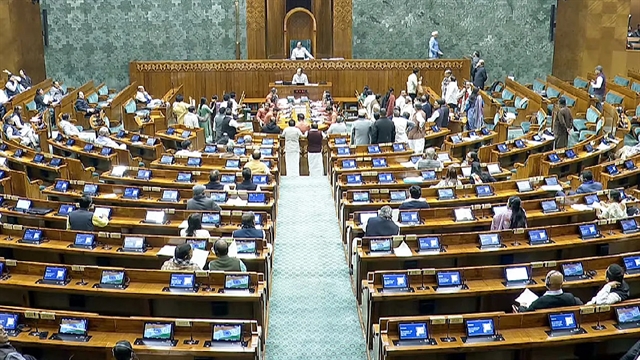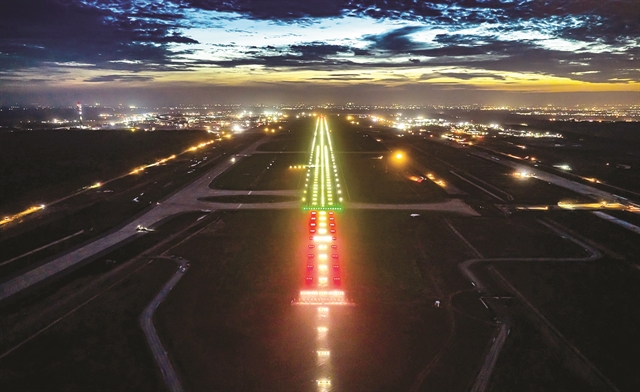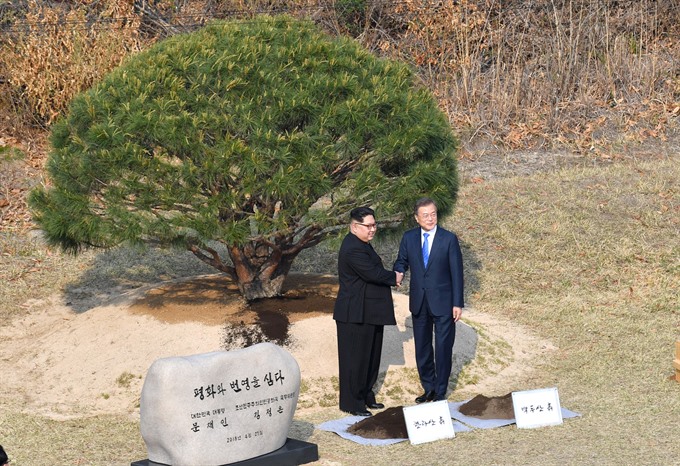 World
World

 |
| South Korean President Moon Jae-in (right) and his North Korean counterpart Kim Jong-un pose after a tree-planting ceremony to mark their historic talks at the truce village of Panmunjom yesterday. — YONHAP/VNA Photo |
PANMUNJOM/GOYANG, South Korea — The leaders of South Korea and North Korea reaffirmed their commitment to the complete denuclearisation of the Korean Peninsula on Friday, while also agreeing to reduce their conventional weapons pending the outcome of their joint efforts to reduce military tension and promote a lasting peace on the Korean Peninsula.
The agreement came in a historic summit between South Korean President Moon Jae-in and North Korean leader Kim Jong-un.
"The two leaders solemnly declared before the 80 million people of our nation and the entire world that there will be no more war on the Korean Peninsula and a new age of peace has opened," they said in a joint declaration signed at the end of their bilateral meeting at the Joint Security Area of Panmunjom.
The two leaders vowed efforts to establish permanent peace on the Korean Peninsula.
"The South and the North reaffirmed their agreement of non-aggression that they will not use any form of force against each other and agreed to strictly abide by the agreement," the joint declaration said.
Moon and Kim also reaffirmed the countries’ earlier agreement to completely denuclearise the Korean Peninsula.
"The South and the North affirmed their mutual goal of realizing a nuclear-free Korean Peninsula through complete denuclearisation," the released statement said.
To formally end the Korean War, the two Koreas agreed to push for three-way or four-way talks involving the United States and China to replace the Korean armistice with a peace treaty.
The two Koreas technically remain at war as the 1950-53 war ended with an armistice, not a peace treaty.
Efforts to reduce military tension will include a complete halt to any type of hostility against each other in all areas, including sea and air.
To discuss additional measures, the two Koreas will hold general-grade military talks before the end of May.
Further, the leaders agreed to a range of measures aimed at promoting peace and reconciliation between the divided Koreas.
First, the countries will hold high-level dialogue in the near future to discuss ways to implement the agreement reached at the third inter-Korean summit, they said.
They will also promote cooperation and exchange between the countries to further the process of reconciliation.
To this end, the countries will hold Red Cross talks to discuss humanitarian issues, including the long-stalled reunions of families separated by the division of the two Koreas.
North and South Korea will hold a reunion in August of around 57,000 families left divided when the Korean War ended 65 years ago, they said after the summit.
"South and North Korea agreed to proceed with reunion programmes for the separated families on the occasion of the National Liberation Day of August 15 this year," they said in a statement, referring to Japan’s surrender at the end of World War II.
Jointly planting pine tree
Also Friday, the leaders of South and North Korea jointly planted a tree, an event that symbolises their wish for peace and prosperity on the Korean Peninsula.
South Korean President Moon Jae-in and North Korean leader Kim Jong-un planted the pine tree together near the Military Demarcation Line (MDL) that separates the two Koreas. The tree-planting came after their historic summit talks held earlier in the day, according to a press release issued by the presidential office of Cheong Wa Dae.
Moon and Kim shoveled soil that had been collected from Mt Halla in the South and Mt Baekdu in the North over the tree’s roots. Kim poured water from the Han River of the South and Moon from the Daedong River of the North.
Moon and Kim unveiled a stone in front of the tree inscribed with their respective names. It also bears the phrase Plant peace and prosperity.
Following the tree planting event, the leaders took a stroll and walked onto the "Foot Bridge". They sat on a bench on the bridge and talked.
Shortly after the armistice was signed, the 50-meter-long bridge was built for the convenience of the staff from the Neutral Nations Supervisory Commission tasked with overseeing the implementation of the armistice.
South and North Korea also agreed to set up a joint permanent liaison office in the North’s border city of Kaesong to facilitate closer communication. "South and North Korea agreed to establish a joint permanent liaison office in Kaesong where officials from both sides are stationed in a bid to seek close consultations and promote civilian exchanges and cooperation," the statement said.
Currently, the two Koreas have respective liaison offices on each side of the border. They use phones and fax machines for communication.
The joint communication office, if established, are expected to prevent miscommunication from hampering inter-Korean ties and help accelerate the regularisation of inter-Korean talks, experts said. — YONHAP/AFP